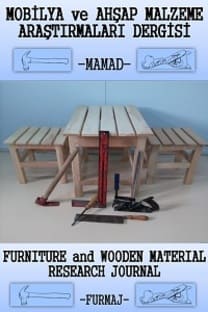Yerli ve yabancı ağaç türlerinin bazı teknolojik özellikleri üzerine deniz suyunun etkisinin araştırılması
Bu çalışmada, Türkiye keresteciliğinde önemli kullanım alanına sahip iki tür olan Sarıçam (Pinus sylvestris L.) ve Doğu Kayını (Fagus orientalis L.) ağaçlarının diri odunları ve Tropik ağaç türü olan Tali (Erythrophleum suaveolens), Teak (Tectona grandis) ve Mkuruti (Baphia kirkii) ağaç türlerinin odunları kullanılmıştır. Bu odun türlerinin fiziksel (yoğunluk) ve mekanik (eğilme direnci, basınç direnci) özelliklerinin belirlenmesi için test numuneleri hazırlanmıştır. Hazırlanan numuneler Tanzanya Zanzibar adasında Hint okyanus suyu içerisinde 1 yıl süre ile bekletilmiştir. Elde edilen bulgular neticesinde sarıçam ve tropik ağaç türlerinin yoğunluk değerlerinin deniz suyuna maruz bırakılması ile arttığı, kayın örneklerinin yoğunluk değerlerinde ise önemli derecede bir değişimin olmadığı belirlenmiştir. Deniz suyuna maruz bırakılan yerli ağaç türlerinin eğilme direnci özelliklerinde kontrol örneklerine kıyasla belirgin bir düşüş görülmüştür. Tropik ağaç türlerinin eğilme dirençlerinde hafif değişimler tespit edilmiş olup, Tali ve Mkuruti örneklerinde ise artış yönünde bir değişim görülmüştür. Yerli ağaç türlerinin basınç direnci özelliklerinde ise deniz suyuna maruz bırakılmış örneklerin kontrol örneklerine nazaran azalma görülürken, tropik ağaç türlerinde ise artış belirlenmiştir.
Investigation of the effect of sea water on some technological properties of domestic and foreign tree species
In this study, the sapwood of Scotch pine (Pinus sylvestris) and Beech (Fagus Orientalis L.) which are the two important species in the Turkey lumber industry and the wood of Tali (Erythrophleum suaveolens), Teak (Tectona grandis), and Mkuruti (Baphia kirkii) which are the tropical species were used. The test specimens were prepared to determine the physical (density) and mechanical (bending strength, compression strength) properties according to standard. The prepared test samples were dipped into Indian Ocean water obtained in Zanzibar Island of Tanzania for one year. It was determined that the density values of Scotch pine and tropical tree species increased with seawater exposure and there was no significant change in the density values of beech samples. The bending strength properties of the local tree species which exposed to seawater were significantly reduced compared to the control samples. Slight variations were determined from bending strength of tropical tree species. A positive interaction was measured from Tali and Mkuruti samples. The decreasing was determined on the compressive strength properties of the local tree species samples which exposed to seawater, while the increase from tropical tree species samples.
___
- Bergman, R., Puettmann, M., Taylor, A., Skog, K. E., (2014), The carbon impacts of wood products, Forest Products Journal 64 (7-8), 220-231. DOI: 10.13073/FPJ-D-14-00047
- Bliven S., Pearlman S., (2003), Small docks and piers, massachussets deparmant of environmental protection, Bureau of Resource Protection Wetlands/ Waterways Program, One Winter Street, Boston MA: 02108.
- Bobat A., (1994), Emprenyeli Ağaç Malzemenin Kapalı Maden Ocaklarında ve Deniz İçinde Kullanımı ve Dayanma Süresi. Karadeniz Teknik Üniversitesi, Fen Bilimleri Enstitüsü, Doktora Tezi, Trabzon, 180 s.
- Bobat, A.,(1999), Çeşitli ağaç türlerinin boring ve fouling organizmalara karşı dayanıklılığı, Mersin: Türkiye Bilimsel ve Teknik Araştırma Grubu.
- Borges, L. M. S., Cragg, S. M., Williams, J. R., (2003), Comparing the resistance of a number of lesser known species of tropical hardwoods to the marine borer Limnoria using a short term laboratory assay (IRG/WP 03-10500), The International Research Group on Wood Preservation, Brisbane, Australia.
- Cheriyan, P.V., Cherian, C. J., (1975), On the Comparative Efficacy of some indigenous methods for the protection of underwater timber structures. Bull. Dept. Mar. Sci. Univ. Cochin. 7, (2), 419-426.
- Cookson, L.J., (1986), Marine Borers and Timber Piling Options, CSIRO Division of Chemical and Wood Technology, Research Review, Australia
- Dillon, J., (2005) Creosote-Treated Wood in Aquatic Environmebonts. Technical Review and Use Recommendations Prepared for, NOAA Fisheries Southwest Division Habitat Conservation Division, Prepared by: Stratus Consulting Inc. PO Box: 4059, Duke University Durham, NC
- Eaton, R. A., (1985), Preservation of Marine Timbers. Preservation of Timber in the Tropics, ed. W.P.K. Findlay, Martinus Nijhoof / DR W. Junk Publishers, ISBN 90-247-3112- 7 Dordrecht, Netherlands, pp. 158.
- Güneş, İ., (2019), Yerli ve Yabancı Ağaç Türlerinin Bazı Teknolojik Özellikleri Üzerine Deniz Suyunun Etkisinin Araştırılması, Kütahya Dumlupınar Üniversitesi, Fen Bilimleri Enstitüsü, Yüksek Lisans tezi, Kütahya.
- Helsing,G.G., (1979), Controlling Wood Deterioration in Waterfront Structures. Sea Technology, 46: 20-21
- Kırlı, L., (2005), Denizlerde Organokalay Kirlenmesi, G.Ü. Fen Bilimleri Dergisi 18 (3), 517- 528.
- Özen, R., (1996), Friedrich Naumann Vakfı, Konferans Notları
- Perçin, O., (2007), Lamine Edilmiş Ahşap Malzemeye Deniz Suyunun Etkisi. Yüksek Lisans Tezi, Dumlupınar Üniversitesi Fen Bilimleri Enstitüsü, Kütahya, 122 s.
- Santhakumaran, L. N., Jain, J. C., (1981), Observations on the destruction of fishing craft in India by marine wood-borers with special reference to the west coast. IRG/WP Document 472, pp. 1-5.
- Sivrikaya, H., (2004), Odunu Tahrip Eden Başlıca Deniz Zararlılar›, ZKÜ Bartın Orman Fakültesi Dergisi (6), 136-141.
- TS2474, (1976), Odunun statik eğilme dayanımının tayini, TSE, Ankara.
- TS 2595, (1976), Odunun liflere paralel dogrultuda basınç dayanımı tayini, TSE, Ankara.
- ISSN: 2636-8625
- Yayın Aralığı: Yılda 2 Sayı
- Başlangıç: 2018
- Yayıncı: Bekir Cihad Bal
Sayıdaki Diğer Makaleler
Kavak odununun bazı fiziksel özellikleri üzerine vakum atmosferinde uygulanan ısıl işlemin etkisi
Bekir Cihad Bal, Murat KILAVUZ
Mobilya endüstrisinde kullanılan kapak konstrüksiyonları üzerine incelemeler
Mehmet DAĞLI, TUNCER DİLİK, Ahmet KURTOĞLU
Zaman etüdü ve ahşap kent mobilyasında bir uygulama örneği
Halil Erdem Erdem YÜCEL, TUNCER DİLİK
Ağaç malzemenin sıkıştırılarak yoğunlaştırılması konusunda yapılan çalışmalar
Mustafa TOSUN, Sait Dündar SOFUOĞLU
